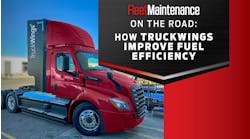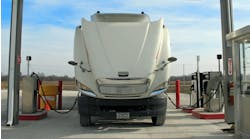After a long-haul truck driver is on the road for hours and needs to sleep for the night, a common practice is to keep the truck idling in order have a power supply and remain comfortable. To solve this problem of prolonged engine idling, Electrified Parking Spaces (EPS) were developed.
The U.S. Environmental Protection Agency (EPA) recognizes EPS, also known as Truck Stop Electrification (TSE), as a verified type Idle Reduction Technology (IRT).
An EPS/TSE is not an on-board device, but rather a solution which operates independently of the truck’s engine and allows the engine to be turned off while it supplies heating, cooling and electrical power to the cab.
Single-system electrification uses off-board, stand-alone equipment at truck stops or parking spaces to provide HVAC system operation using a hose which connects to the trucks window. This may require a window template be installed, usually provided by the TSE provider.
The window template can be a disadvantage because of issues with fit, seeing as there are 75 different window configurations on today’s heavy duty trucks alone, ranging from 17” to 43” wide, according to North American Council for Freight Efficiency (NACFE)’s Idle Reduction Confidence Report.
There is also a dual-system electrification, or shore power, option which uses both on-board and off-board equipment. Trucks must be equipped with A/C equipment or an inverter to convert 120-volt power, electrical equipment, like an electrical HVAC system, and hardware to plug in to the electrical outlet.
At this time, the utilization of these systems overall is “rather low” because of the limited number of providers across the U.S.



